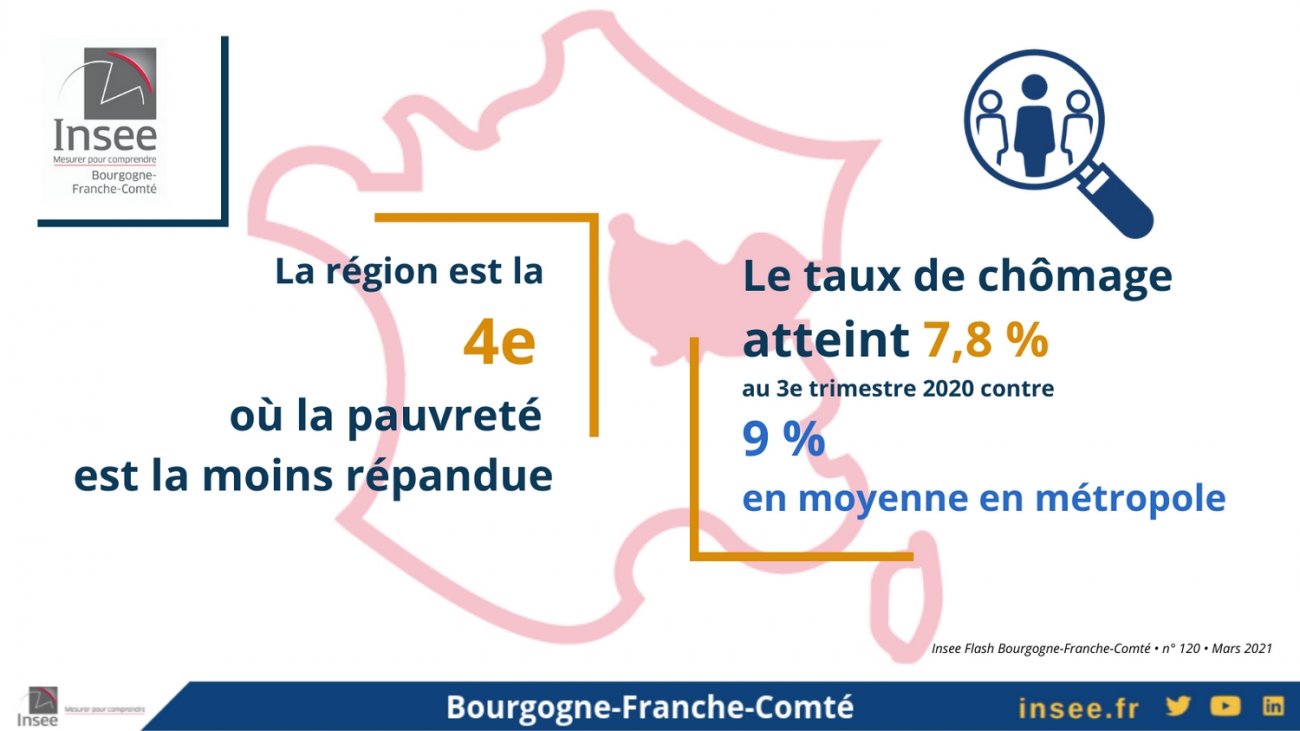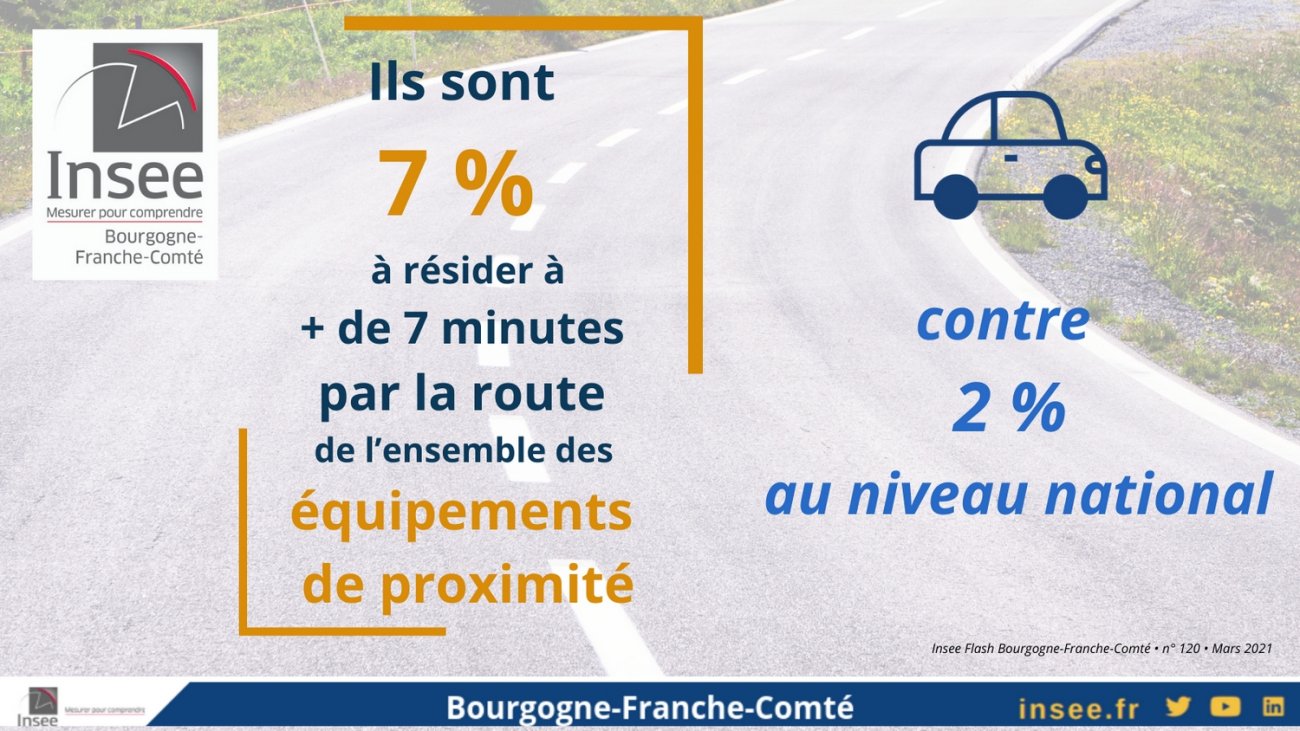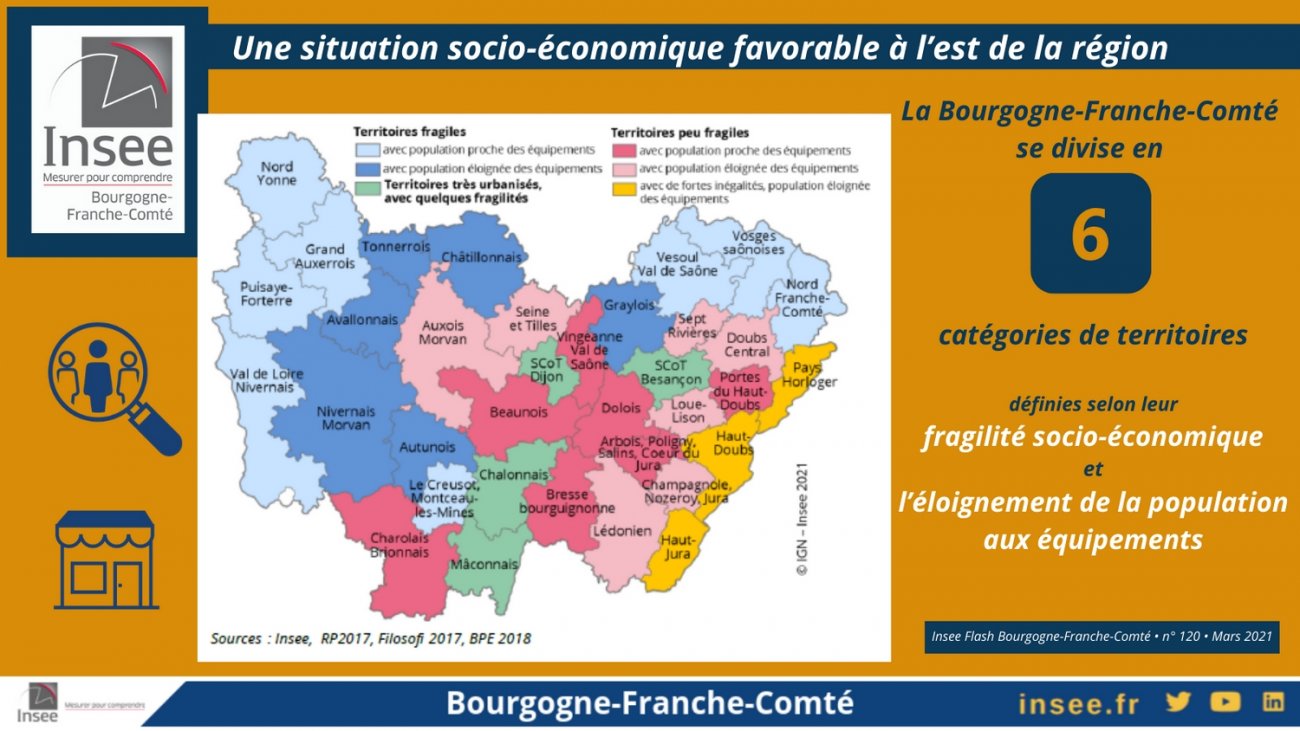Bourgogne-Franche-Comté is the 4th region where poverty is the least widespread. But nearly 13% of the region’s inhabitants are more than 7 minutes from a general practitioner compared to 6% on average for the whole of France.
Socio-economic weaknesses more contained than at the national level
Sustainable development aims to support economic activity that ensures satisfactory living conditions for all while not compromising future living conditions on Earth. Bourgogne-Franche-Comté has a rather favorable socio-economic profile in France with relatively contained monetary poverty, income inequalities and unemployment. On the other hand, the educational level of young people appears to be lower and access to equipment is often more complicated, especially in the west of the region.
Sustainable development aims to reconcile respect for the biosphere and the improvement of living conditions. Also, economic activity to be sustainable must not exceed an “environmental ceiling”. Respect for this must not, moreover, compromise the achievement of a “social floor” which aims to ensure satisfactory living conditions for all. However, Bourgogne-Franche-Comté is one of the French regions the most spared from socio-economic weaknesses.
Relatively contained income inequalities
The median standard of living of the region’s population is comparable to the average for mainland France, but the inequalities are less marked. The richest 10% earn on average 3 times more than the poorest 10%. This ratio is lower than on average in metropolitan France, where it reaches 3.4.
Income poverty is also less frequent. Almost 13% of the regional population lived below the poverty line in 2018, that is to say with less than € 1,063 per month for a single adult, against 14.6% in mainland France. The region is thus the 4th where poverty is least widespread. The unemployment rate is also more contained. It reached 7.8% in the third quarter of 2020 against 9% on average in metropolitan France.
Graduates but especially in short qualifying training
The integration of young people requires the acquisition of skills. In Bourgogne-Franche-Comté, young people participating in Defense and Citizenship Day more often have reading difficulties than at the national level, 12.1 against 10.5%. Nonetheless, young people aged 20 to 24 who left school more often than the average. Those aged 30-34, however, have a lower level. Thus, 40% are graduates of higher education in the region, against 46% in mainland France.
This is explained by the industrial and agricultural nature of the companies in the region, which helps to maintain and develop short qualifying training (CAP, BEP, vocational baccalaureate, etc.). Young people are also moving away from the region to pursue higher education, in Paris and Lyon where the training offer is more diversified, or to access areas offering more opportunities for more qualified jobs.
More difficult access to health-related equipment
Bourgogne-Franche-Comté is a vast territory and has an urban framework made up of towns of often modest size. They offer the necessary equipment and quickly accessible to the greatest number of inhabitants. Nevertheless, those who are far from it are quite numerous. 7% of them live more than 7 minutes by road from all local amenities, compared to 2% nationally. Bourgogne-Franche-Comté ranks second to last among metropolitan regions, ahead of Corsica.
The distance is marked for equipment related to health. Almost 13% of the region’s inhabitants are more than 7 minutes from a general practitioner compared to 6% on average. The same goes for dental surgeons, 26% against 12%.
If the number of premature deaths (before age 65) has decreased in ten years in Bourgogne-Franche-Comté, they are more numerous than at the national level (+ 4%), for an equivalent age and sex structure. The region is the 4th in France where this excess mortality is the highest.
Half could be avoided. The fight against avoidable mortality involves reducing risky behaviors (alcohol, tobacco, etc.), and improving the care of people by the health care system (prevention, early care, etc.).
A favorable socio-economic situation in the east of the region
Bourgogne-Franche-Comté is divided into six categories of territories, defined according to their socio-economic fragility and the distance of the population to amenities.
The least fragile territories are mainly located in the eastern part, and in the crown of the Dijon agglomeration. Monetary poverty, long-term unemployment, and young people aged 16 to 25 who are not integrated (that is to say neither in studies, neither in employment nor in training) are less frequent there than in the rest of the country. region.
The speed with which to access equipment and services is, on the other hand, very variable. In the Dolois and Burgundian Bresse, less than 3% of the population lives more than 7 minutes from local facilities, while one in three is in this case in Auxois Morvan.
The Watchmaking Country, Haut-Doubs and Haut-Jura are close to Switzerland, border work concerns many workers. They are little affected by unemployment, and are among the regions in the region where income poverty is least common. In the Watchmaking Country, it concerns less than 7% of the population. The standard of living is the highest in the region, but the income inequalities are significant.
The territories in the west of the region are more fragile and less well equipped
Conversely, the most fragile territories are located to the west and northeast of the region. Monetary poverty is more frequent, it concerns at least 13.8% of the inhabitants, and up to 18% in the Nivernais Morvan. Mortality is also higher there than elsewhere. It is, for example, in the Nivernais Morvan, 14% higher than the metropolitan average.
Many determinants influence the health status and life expectancy of a population. In these poor areas, the inhabitants, often poorly educated, therefore occupy less qualified jobs, which expose them more frequently to occupational risks. In line with their standard of living, their housing conditions are less favorable. Risk behaviors (alcohol, tobacco, etc.) are more widespread and their relationship with the medical sphere is more complex, even distant. In these areas, often with an industrial tradition and in loss of jobs, up to 10% of workers have declared themselves unemployed for more than a year and 30% of young people have little or no integration.
In the Morvan and the north of the Côte-d’Or, social fragility is reinforced by difficulties in accessing equipment. Half of the population of Châtillonnais is more than 7 minutes on average from local facilities.
Very good access to equipment but strong inequalities in urban centers
Certain highly urbanized areas in the region, such as those in the territorial coherence schemes (SCoT) of Dijon and Besançon, as well as Chalonnais and Mâconnais, have a mixed profile. The population is close to amenities, which are concentrated in the cities. The standard of living of the inhabitants is rather high, but it masks social inequalities and fragilities.
Monetary poverty is particularly present in the districts of the city’s policy and contrasts sharply with the districts where the population is well-off.
David Brion, Caroline Desnoyers, Hélène Ville (Insee)
Definitions
The standard of living of individuals in a household relates all their income net of direct taxes to the number of consumption units present in the household.
The poverty rate relates the number of individuals living below the poverty line to the total population. The poverty line is set at 60% of the median standard of living of the French.
The objective of classifying equipment into ranges is to bring together equipment that has similar layout logic, in the sense that they are frequently present in the same municipalities: proximity range, intermediate range and upper range.
Communicated



–


